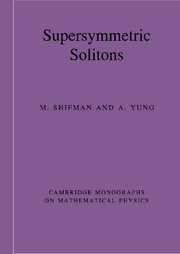Book contents
- Frontmatter
- Contents
- Acknowledgments
- List of abbreviations
- 1 Introduction
- I SHORT EXCURSION
- II LONG JOURNEY
- Introduction to Part II
- 4 Non-Abelian strings
- 5 Less supersymmetry
- 6 Non-BPS non-Abelian strings
- 7 Strings on the Higgs branches
- 8 Domain walls as D-brane prototypes
- 9 Wall-string junctions
- 10 Conclusions
- Appendix A Conventions and notation
- Appendix B Many faces of two-dimensional supersymmetric CP(N – 1) model
- Appendix C Strings in N = 2 SQED
- References
- Index
- Author index
4 - Non-Abelian strings
from II - LONG JOURNEY
Published online by Cambridge University Press: 28 July 2009
- Frontmatter
- Contents
- Acknowledgments
- List of abbreviations
- 1 Introduction
- I SHORT EXCURSION
- II LONG JOURNEY
- Introduction to Part II
- 4 Non-Abelian strings
- 5 Less supersymmetry
- 6 Non-BPS non-Abelian strings
- 7 Strings on the Higgs branches
- 8 Domain walls as D-brane prototypes
- 9 Wall-string junctions
- 10 Conclusions
- Appendix A Conventions and notation
- Appendix B Many faces of two-dimensional supersymmetric CP(N – 1) model
- Appendix C Strings in N = 2 SQED
- References
- Index
- Author index
Summary
In this chapter we discuss a particular class of N = 2 supersymmetric gauge theories in which non-Abelian strings were found. One can pose the question: what is so special about these models that makes an Abelian ZN string become non-Abelian? Models we will dwell on below have both gauge and flavor symmetries broken by the condensation of scalar fields. The common feature of these models is that some global diagonal combination of color and flavor groups survive the breaking. We consider the case when this diagonal group is SU(N)C+F, where the subscript C + F means a combination of global color and flavor groups. The presence of this unbroken subgroup is responsible for the occurrence of the orientational zero modes of the string which entail its non-Abelian nature.
Clearly, the presence of supersymmetry is not important for the construction of non-Abelian strings. In particular, while here we focus on the BPS non-Abelian strings in N = 2 supersymmetric gauge theories, in Chapter 5 we review non-Abelian strings in N = 1 supersymmetric theories and in Chapter 6 in nonsupersymmetric theories.
Basic model: N = 2 SQCD
The model we will deal with derives from N = 2 SQCD with the gauge group SU(N + 1) and Nf = N flavors of the fundamental matter hypermultiplets which we will call quarks [3]. At a generic point on the Coulomb branch of this theory, the gauge group is broken down to U(1)N.
- Type
- Chapter
- Information
- Supersymmetric Solitons , pp. 85 - 141Publisher: Cambridge University PressPrint publication year: 2009



